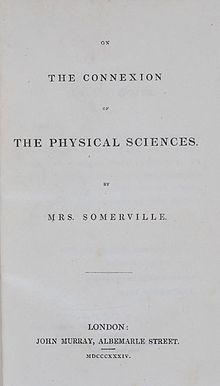On the Connexion of the Physical Sciences
 On the Connexion of the Physical Sciences, title page, 1834 | |
| Author | Mary Somerville |
|---|---|
| Country | United Kingdom |
| Language | English |
| Subject | Science |
| Genre | Popular science |
| Publisher | John Murray |
| Media type | |
On the Connexion of the Physical Sciences is one of the best-selling science books of the 19th century written by Mary Somerville in 1834.[1] The book went through many editions and was translated into several European languages. It is considered one of the first popular science books, containing few diagrams and very little mathematics. It describes astronomy, physics, chemistry, geography, meteorology and electromagnetism as they were scientifically understood at the time.[2][3][4][5] In a review of the book in March 1834, William Whewell coined the word "scientist".[6][7]
References[]
- ^ "Review of On the Connexion of the Physical Sciences by Mrs. Sommerville". The Quarterly Review. 51: 54–68. March 1834.
- ^ "Nature Podcast". 30 October 2014. Retrieved 5 November 2014.
- ^ Holmes, Richard (2014). "In retrospect: On the Connexion of the Physical Sciences". Nature. 514 (7523): 432–433. doi:10.1038/514432a. ISSN 0028-0836.
- ^ Secord, James (2014-03-18). Visions of Science: Books and readers at the dawn of the Victorian age. OUP Oxford. pp. 107–134. ISBN 9780191662751. Retrieved 5 November 2014.
- ^ Patterson, E. C.; Eisberg, J (June 1985). "Book Review: "The Queen of Nineteenth-Century Science": Mary Somerville and the Cultivation of Science, 1815–1840". Journal for the History of Astronomy. 16 (2): 144–146. Bibcode:1985JHA....16..144P. doi:10.1177/002182868501600209. S2CID 126405732.
- ^ Ross, Sydney (1962-06-01). "Scientist: The story of a word". Annals of Science. 18 (2): 65–85. doi:10.1080/00033796200202722. ISSN 0003-3790.
- ^ Warner, Deborah Jean (1990-03-01). "What is a scientific instrument, when did it become one, and why?". The British Journal for the History of Science. 23 (1): 86. doi:10.1017/S0007087400044460. ISSN 1474-001X.
External links[]
Categories:
- Popular science books
- 1834 non-fiction books
- Books by Mary Somerville
- English non-fiction books
- English-language books
- Scottish books
- Science book stubs